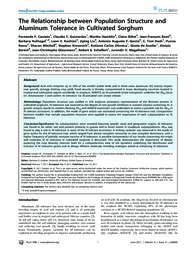The relationship between population structure and aluminum tolerance in cultivated sorghum.
The relationship between population structure and aluminum tolerance in cultivated sorghum.
Author(s): CANIATO, F. F.; GUIMARAES, C. T.; HAMBLIN, M.; BILLOT, C.; RAMI, J.-F.; HUFNAGEL, B.; KOCHIAN, L. V.; LIU, J.; GARCIA, A. A. F.; HASH, C. T.; RAMU, P.; MITCHELL, S.; KRESIVICH, S.; OLIVEIRA, A. C. de; AVELLAR, G. de; BORÉM, A.; GLASZMANN, J.-C.; SCHAFFERT, R. E.; MAGALHAES, J. V.
Summary: Background: Acid soils comprise up to 50% of the world?s arable lands and in these areas aluminum (Al) toxicity impairs root growth, strongly limiting crop yield. Food security is thereby compromised in many developing countries located in tropical and subtropical regions worldwide. In sorghum, SbMATE, an Al-activated citrate transporter, underlies the AltSB locus on chromosome 3 and confers Al tolerance via Al-activated root citrate release. Methodology: Population structure was studied in 254 sorghum accessions representative of the diversity present in cultivated sorghums. Al tolerance was assessed as the degree of root growth inhibition in nutrient solution containing Al. A genetic analysis based on markers flanking AltSB and SbMATE expression was undertaken to assess a possible role for AltSB in Al tolerant accessions. In addition, the mode of gene action was estimated concerning the Al tolerance trait. Comparisons between models that include population structure were applied to assess the importance of each subpopulation to Al tolerance. Conclusion/Significance: Six subpopulations were revealed featuring specific racial and geographic origins. Al tolerance was found to be rather rare and present primarily in guinea and to lesser extent in caudatum subpopulations. AltSB was found to play a role in Al tolerance in most of the Al tolerant accessions. A striking variation was observed in the mode of gene action for the Al tolerance trait, which ranged from almost complete recessivity to near complete dominance, with a higher frequency of partially recessive sources of Al tolerance. A possible interpretation of our results concerning the origin and evolution of Al tolerance in cultivated sorghum is discussed. This study demonstrates the importance of deeply exploring the crop diversity reservoir both for a comprehensive view of the dynamics underlying the distribution and function of Al tolerance genes and to design efficient molecular breeding strategies aimed at enhancing Al tolerance.
Publication year: 2011
Types of publication: Journal article
Unit: Embrapa Maize & Sorghum
Keywords: Sorgo
Observation
Some of Embrapa's publications are published as ePub files. To read them, use or download one of the following free software options to your computer or mobile device. Android: Google Play Books; IOS: iBooks; Windows and Linux: Calibre.
Access other publications
Access the Agricultural Research Database (BDPA) to consult Embrapa's full library collection and records.
Visit Embrapa Bookstore to purchase books and other publications sold by Embrapa.

